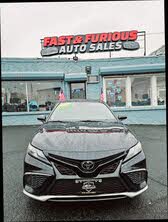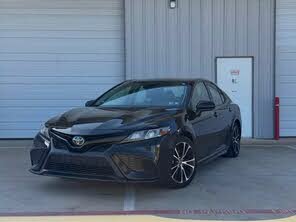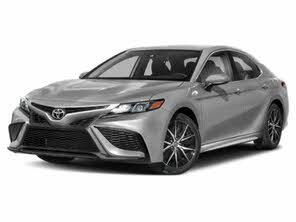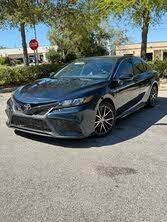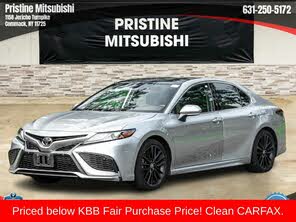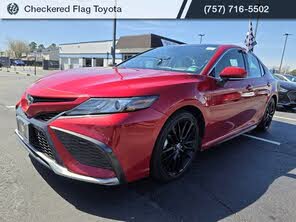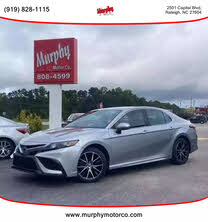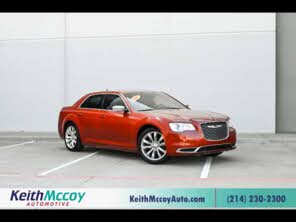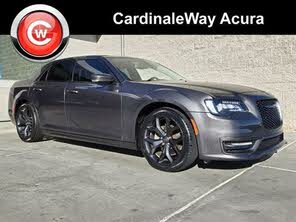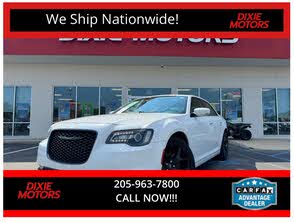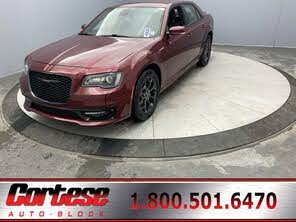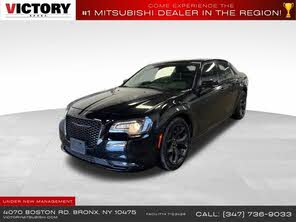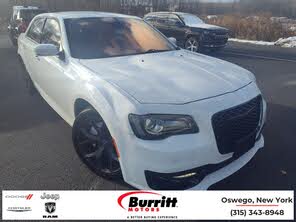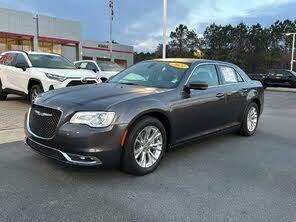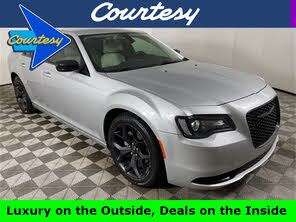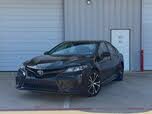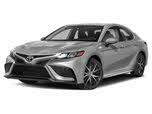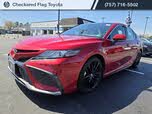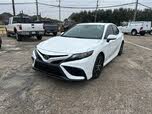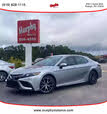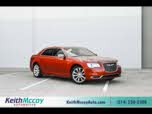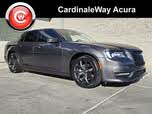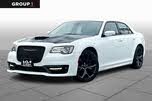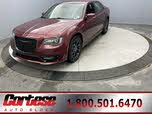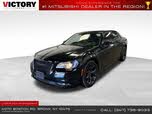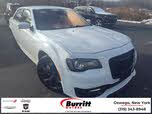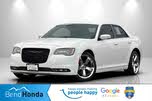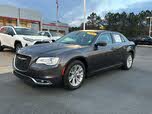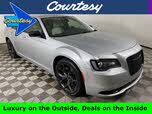2021 Toyota Camry vs 2021 Chrysler 300
Overview | |
MSRP$25,045 | MSRP$31,875 |
Average price$22,631 | Average price$22,869 |
Listings2003 | Listings313 |
Ratings & Reviews | |
User Reviews | User Reviews |
Expert reviews7.8 out of 10 | Expert reviews7.7 out of 10 |
Pros
| Pros
|
2021 Toyota Camry Reviews SummaryThe Toyota Camry has long been many new-car buyers’ default choice—but not because it’s interesting. Reliability and practicality have traditionally been the Camry’s strengths, not sportiness or style. Toyota tried to change that for the 2018 model year, when the Camry was last redesigned. The current-generation Camry adopted more extroverted styling, and engineers tried to make the driving experience more exciting, too. While Toyota’s approach has changed, the Camry still competes against the same array of midsize sedans, including the Honda Accord, Hyundai Sonata, Mazda 6, Nissan Altima, Subaru Legacy, and Volkswagen Passat. Changes for the 2021 model year include subtle styling tweaks, new infotainment displays, an upgrade to the Toyota Safety Sense 2.5+ (TSS 2.5+) package of driver aids, some changes to the dashboard trim, and the discontinuation of the Camry L trim level. That leaves the Camry LE as the new base trim level. The Camry offers buyers more choices than many rivals, encompassing three powertrains (inline-four, V6, and hybrid), six trim levels (LE, XLE, SE, SE Nightshade Edition, XSE, and TRD), and the choice of front-wheel drive (FWD) or all-wheel drive (AWD). Our test car was an AWD SE Nightshade Edition, positioned close to the middle of the lineup. | |
2021 Chrysler 300 Reviews SummaryYou might think the 2021 Chrysler 300 is getting long in the tooth. And you’d be right. This car is so old that it's been through three different car companies (if you count the first generation). But like an aging starting catcher who has watched three different managers come and go, the Chrysler 300 still delivers on a daily basis. It provides North American consumers with a proper front-engine, rear-wheel drive (RWD) luxury sedan at a reasonable price. No other American manufacturer offers that, and you’d be hard-pressed to find anything that competes with it from Europe, Japan or Korea. Starting at just $31,000 MSRP, and offering options for all-wheel drive (AWD) or a 5.7-liter Hemi V8 engine, it’s no wonder that an average of 43,000 new car buyers a year have found the 300 so appealing since the second generation arrived for the 2011 model year. | |
No video found | No video found |
Popular Features & Specs | |
Engine2.5L 203 hp I4 | Engine3.6L 292 hp V6 |
Drive TrainFWD | Drive TrainRWD |
Seating Capacity5 | Seating Capacity5 |
Horsepower | Horsepower292 hp @ 6350 rpm |
MPG City28 | MPG City19 |
MPG Highway39 | MPG Highway30 |
Engine | |
Engine Name2.5L 203 hp I4 | Engine Name3.6L 292 hp V6 |
Torque | Torque260 lb-ft @ 4800 rpm |
Horsepower | Horsepower292 hp @ 6350 rpm |
DrivetrainFWD | DrivetrainRWD |
Fuel Economy | |
MPG City28 | MPG City19 |
MPG Highway39 | MPG Highway30 |
Interior | |
Seating Capacity5 | Seating Capacity5 |
Safety | |
Front Crash Overall5 | Front Crash Overall4 |
Side Crash Overall5 | Side Crash Overall5 |
Dimensions & Capacity | |
Cargo Space15.1 cu ft | Cargo Space16.3 cu ft |
Curb Weight3310 lbs | Curb Weight4013 lbs |
Height56.9 in | Height58.5 in |
Length192.1 in | Length198.6 in |
Width72.4 in | Width75.0 in |
Wheelbase111.2 in | Wheelbase120.0 in |
Maximum Payload925 lbs | Maximum Payload1087 lbs |
Number of doors4 | Number of doors4 |
Maximum Towing Capacity | Maximum Towing Capacity1000 lbs |
Overview | ||
MSRP | $25,045 | $31,875 |
Average price | $22,631 | $22,869 |
Listings | ||
Ratings & Reviews | ||
User reviews | ||
Expert reviews | 7.8 out of 10Read full review | 7.7 out of 10Read full review |
Pros & cons | Pros
| Pros
|
Summary | The Toyota Camry has long been many new-car buyers’ default choice—but not because it’s interesting. Reliability and practicality have traditionally been the Camry’s strengths, not sportiness or style. Toyota tried to change that for the 2018 model year, when the Camry was last redesigned. The current-generation Camry adopted more extroverted styling, and engineers tried to make the driving experience more exciting, too. While Toyota’s approach has changed, the Camry still competes against the same array of midsize sedans, including the Honda Accord, Hyundai Sonata, Mazda 6, Nissan Altima, Subaru Legacy, and Volkswagen Passat. Changes for the 2021 model year include subtle styling tweaks, new infotainment displays, an upgrade to the Toyota Safety Sense 2.5+ (TSS 2.5+) package of driver aids, some changes to the dashboard trim, and the discontinuation of the Camry L trim level. That leaves the Camry LE as the new base trim level. The Camry offers buyers more choices than many rivals, encompassing three powertrains (inline-four, V6, and hybrid), six trim levels (LE, XLE, SE, SE Nightshade Edition, XSE, and TRD), and the choice of front-wheel drive (FWD) or all-wheel drive (AWD). Our test car was an AWD SE Nightshade Edition, positioned close to the middle of the lineup. | You might think the 2021 Chrysler 300 is getting long in the tooth. And you’d be right. This car is so old that it's been through three different car companies (if you count the first generation). But like an aging starting catcher who has watched three different managers come and go, the Chrysler 300 still delivers on a daily basis. It provides North American consumers with a proper front-engine, rear-wheel drive (RWD) luxury sedan at a reasonable price. No other American manufacturer offers that, and you’d be hard-pressed to find anything that competes with it from Europe, Japan or Korea. Starting at just $31,000 MSRP, and offering options for all-wheel drive (AWD) or a 5.7-liter Hemi V8 engine, it’s no wonder that an average of 43,000 new car buyers a year have found the 300 so appealing since the second generation arrived for the 2011 model year. |
Video | No video found | No video found |
Popular Features & Specs | ||
Engine | 2.5L 203 hp I4 | 3.6L 292 hp V6 |
Drive Train | FWD | RWD |
Seating Capacity | 5 | 5 |
Horsepower | 292 hp @ 6350 rpm | |
MPG City | 28 | 19 |
MPG Highway | 39 | 30 |
Engine | ||
Engine Name | 2.5L 203 hp I4 | 3.6L 292 hp V6 |
Torque | 260 lb-ft @ 4800 rpm | |
Horsepower | 292 hp @ 6350 rpm | |
Drivetrain | FWD | RWD |
Fuel Economy | ||
MPG City | 28 | 19 |
MPG Highway | 39 | 30 |
Interior | ||
Seating Capacity | 5 | 5 |
Safety | ||
Front Crash Overall | 5 | 4 |
Side Crash Overall | 5 | 5 |
Dimensions & Capacity | ||
Cargo Space | 15.1 cu ft | 16.3 cu ft |
Curb Weight | 3310 lbs | 4013 lbs |
Height | 56.9 in | 58.5 in |
Length | 192.1 in | 198.6 in |
Width | 72.4 in | 75.0 in |
Wheelbase | 111.2 in | 120.0 in |
Maximum Payload | 925 lbs | 1087 lbs |
Number of doors | 4 | 4 |
Maximum Towing Capacity | 1000 lbs | |
The 2021 Toyota Camry sought to break away from its mundane past by embracing a more exciting design language. Designers added multiple styling details to make the vehicle look sportier and more dynamic. The car's effective styling elements included flared wheel arches and thin headlights and taillights, which gave the car a wider appearance. However, SE, XSE, and TRD trim levels were adorned with fake vents, creating visual clutter. The LE and XLE trims boasted a somewhat cleaner but still massive grille. Underneath, the Camry sat on the TNGA-K platform, also used in the Avalon sedan and RAV4 SUV.
For 2021, the model received subtle front-fascia updates across most trim levels, while the TRD performance model featured a larger rear spoiler and unique styling cues. The Nightshade Edition, based on the SE trim, sported blacked-out exterior trim and wheels. Wheel options ranged from standard 17-inch alloys on the base LE to available 18-inch and 19-inch wheels on higher trims.
Inside, the Camry's interior appeared as chaotic as its exterior. Our SE Nightshade Edition test model's dashboard seemed cobbled together from different vehicles, incorporating a mix of contrast stitching, piano black plastic, and faux carbon fiber. XLE and XSE models offered leather upholstery. Overall, the materials used in the Camry's cabin felt low quality.
The 2021 Chrysler 300 retained much of its original design since the major facelift in 2014. Its "three-box design" created a classic and straightforward profile, embodying a nostalgic charm without falling into the retrofuturist trap. From the base trim to the high-end 300S, the vehicle exuded pride in its traditional design.
The grille and headlights had evolved over the years. The 2021 model came with bi-xenon halogen projector lamps and LED driving lamps on lower trims, while the Comfort Group on higher trims added adaptive HID lamps. Depending on the package and trim, the grille could be black or chrome, maintaining a tough, no-nonsense look.
Wheel options included 17-inch silver alloys on the base 300 Touring trim and 18-inch polished alloys on the 300 Touring L, with 19-inch and 20-inch options on upper trims, including the 20-inch Black Noise wheels standard on the 300S.
Inside, the 300 offered a high level of interior quality. The base Touring trim featured cloth upholstery with an eight-way power driver’s seat while higher trims like the 300 Touring L and 300S came with standard Nappa leather upholstery and added luxury touches like perforated inserts and accent stitching. Heated front seats were standard on the top trims, with heated rear seats available.
The 2021 Toyota Camry offered multiple powertrain options. The base 2.5-liter four-cylinder engine, named "Dynamic Force," delivered 203 horsepower and 184 pound-feet of torque with FWD, and 202 hp and 182 lb-ft with AWD. The XSE trim’s dual-exhaust system increased output to 206 hp and 186 lb-ft (FWD) and 205 hp and 185 lb-ft (AWD). Both FWD and AWD versions came with an eight-speed automatic transmission.
Toyota also offered a naturally-aspirated 3.5-liter V6, producing 301 hp and 267 lb-ft of torque, paired with the same eight-speed automatic as the four-cylinder. The 2021 Camry Hybrid combined a 2.5-liter four-cylinder engine with electric assist, delivering a total system output of 208 hp, only available with FWD.
Our SE Nightshade Edition tester featured the base four-cylinder with AWD, surprising us with its performance. The Dynamic Force engine was eager to rev, providing ample grunt and a pleasing sound. The chassis struck a balance between handling and ride quality, making the Camry enjoyable in corners without a harsh ride. Though not as sharp as the Honda Accord or Mazda 6, it offered a rewarding experience for driving enthusiasts.
Toyota even brought back AWD in 2020, derived from the RAV4 AWD system, capable of sending up to 50% of torque to the rear wheels. The setup did not impact passenger or cargo space.
The 2021 Chrysler 300 offered a 3.6-liter Pentastar V6 engine, providing 292 horsepower and 260 pound-feet of torque in the 300 Touring and 300 Touring L, and 300 hp and 264 lb-ft in the 300S. The 300S also had an optional 5.7-liter V8, delivering 363 hp and 394 lb-ft of torque. Both engines came with an eight-speed automatic transmission, with paddle shifters on the 300S. RWD was standard, while AWD was a $2,750 option on some trims but unavailable on the 300S.
In the base trim with RWD and the V6, the 300 felt like an upgrade from rental cars, offering a quiet, capable, and comfortable ride. Higher trims, such as the AWD Touring L, provided a traditional luxury experience. The V8-powered 300S added excitement with its Hemi engine, making it enjoyable to drive, even if it didn’t match the higher-performance engines in the Dodge Charger.
The Camry's interior provided generous rear headroom and legroom compared to other midsize sedans, though front headroom and legroom were below average. However, the front seats were adjustable and supportive, and outward visibility was excellent. Cargo space was 15.1 cubic feet, average for the class but less than the Honda Accord's 16.7 cubic feet. In-cabin storage was limited, with small cupholders and door bottle holders.
Chrysler 300 excelled in interior space, offering generous front and rear legroom. With 41.8 inches in the front and 40.1 inches in the back, it outclassed the Lexus ES350 and competed with the Toyota Avalon and Volvo S90. The sedan provided 106.3 cubic feet of passenger volume, surpassing the Genesis G70 and Lexus ES350. Trunk volume was strong at 16.3 cubic feet, enough for four large suitcases, making it more practical than the Camry for cargo.
The Camry's standard infotainment system included a 7-inch touchscreen, Apple CarPlay and Android Auto connectivity, Amazon Alexa compatibility, Bluetooth, Siri Eyes Free voice control, and SiriusXM satellite radio (three-month free trial). Higher trims featured a 9-inch touchscreen, WiFi for five devices, navigation, and a nine-speaker JBL audio system. The XSE and XLE trims offered a 10-inch head-up display (HUD). Standard USB ports included a media port and two charge ports, plus a 12-volt outlet. Toyota’s user-friendly infotainment system had plain graphics but remained highly functional.
The Chrysler 300 retained its Uconnect 4C infotainment system with an 8.4-inch touchscreen, praised for its intuitive layout and functionality. It included Apple CarPlay and Android Auto as standard. Across all trims, the 8.4-inch touchscreen was a welcome standard feature. The $3,495 Popular Equipment Group added premium audio with a 506-watt amp, nine Alpine speakers, GPS navigation, SiriusXM Traffic Plus (five-year subscription), surround sound, a trunk-mounted subwoofer, and a dual-pane sunroof, significantly upgrading the tech setup.
The 2021 Toyota Camry earned top safety ratings, achieving a “Top Safety Pick+” from IIHS and a five-star overall rating from NHTSA, with five-star scores in front, side, and rollover crash tests. The new TSS 2.5+ safety package was standard, offering adaptive cruise control, automatic emergency braking, forward-collision warning (with pedestrian detection), lane-departure warning, automatic high beams, traffic-sign recognition, and enhanced capabilities. Features included a rear seat reminder and available blind-spot monitoring and rear cross-traffic alert.
The 2021 Chrysler 300 received top "Good" scores in most IIHS crash tests except for "Marginal" in small overlap tests and "Poor" for headlights. NHTSA rated it four stars overall, with four-star driver, passenger, and rollover ratings, but five stars in combined side barrier and side pole crash tests. Standard safety features included active head restraints, multiple airbags, traction control, stability control with brake assist, rain brake support, ready alert braking, and hill start assist. Advanced safety features were only available on higher trims through packages, making the 300 less competitive in terms of standard safety equipment.
CarGurus highlights

According to CarGurus experts, the overall rating for the 2021 Toyota Camry was 7.8 out of 10, while the 2021 Chrysler 300 scored 7.7 out of 10. Based on these ratings, the 2021 Toyota Camry takes the win. Its combination of advanced safety features, engaging driving dynamics, and user-friendly technology makes it the better choice for most consumers.
Choose the 2021 Toyota Camry if:
- You prioritize top-tier safety ratings and advanced safety features on all trims.
- You value a sportier driving experience with multiple powertrain options.
- You appreciate a user-friendly infotainment system with standard tech features.
Choose the 2021 Chrysler 300 if:
- You seek a spacious and luxurious interior with more passenger and trunk space.
- You prefer a traditional, classic design with consistent quality.
- You want a powerful V8 option for an exhilarating driving experience.
CarGurus highlights

According to CarGurus experts, the overall rating for the 2021 Toyota Camry was 7.8 out of 10, while the 2021 Chrysler 300 scored 7.7 out of 10. Based on these ratings, the 2021 Toyota Camry takes the win. Its combination of advanced safety features, engaging driving dynamics, and user-friendly technology makes it the better choice for most consumers.
Choose the 2021 Toyota Camry if:
Shop Now- You prioritize top-tier safety ratings and advanced safety features on all trims.
- You value a sportier driving experience with multiple powertrain options.
- You appreciate a user-friendly infotainment system with standard tech features.
Choose the 2021 Chrysler 300 if:
Shop Now- You seek a spacious and luxurious interior with more passenger and trunk space.
- You prefer a traditional, classic design with consistent quality.
- You want a powerful V8 option for an exhilarating driving experience.

By: CarGurus + AI
At CarGurus, our team of experienced automotive writers remain at the heart of our content operation, conducting hands-on car tests and writing insightful guides that are backed by years of industry experience. To complement this, we are harnessing AI to make our content offering more diverse and more helpful to shoppers than ever. To achieve this, our AI systems are based exclusively on CarGurus content, ratings and data, so that what we produce is both unique to CarGurus, and uniquely helpful to car shoppers.

















